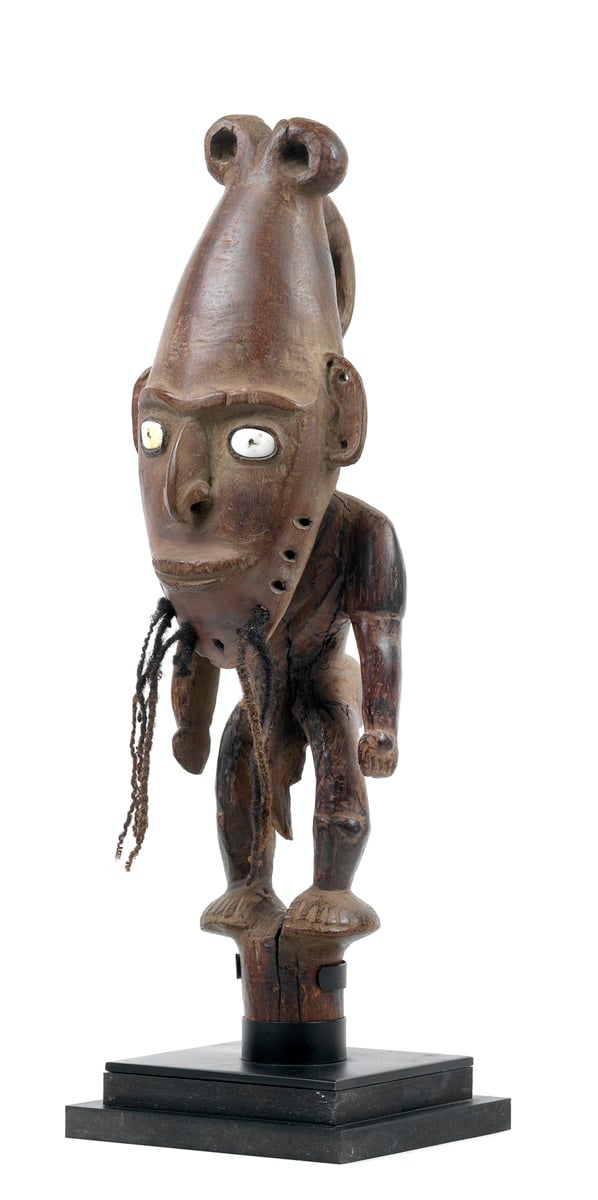
At Vienna’s Dorotheum on Tuesday anticipation was ripe for lot 201. But, what the house had deemed a “museum-quality” figurine from the Biwat people of New Guinea that graced the auction’s catalogue cover never made it to the auction block. Why? Rather than a last minute private sale, the so-called “Wusear”—a male figurine used as a stopper for sacred flutes used in Biwat initiation ceremonies—is thought to be a fake.
In an interview with artnet News, the Dorotheum’s Tribal Art specialist Erwin Melchardt said, “[As] Soon as the catalogue was published, some good friends and collectors called me up and stated some doubts [about] the piece and the ‘old label’.” While no final conclusion regarding the Wusear’s authenticity or lack thereof has yet been made, Melchardt says he pulled it out of abundant caution, despite the embarrassment to his fledgling department. “I want to keep my auctions [at the Dorotheum] very, very clean!” he says, “If there is any doubt in a piece, I take it out–even when it is on the front cover of a catalogue.”
The piece had a seemingly airtight provenance. According to the catalogue and a press release sent out on March 4, it was acquired by its current Belgian owner at auction in 2009 or 2010 with the only intermediary owner—also said to be a well-known collector—having purchased it from the estate of German adventurer, merchant, and collector Franz Emil Hellwig (1854-1929) in 2000. The Belgian presented Melchardt with the now-questionable label for documentation with various notes about the Wusear and the number 1904 on it, the piece’s supposed collection date.
At the time, the label seemed only to bolster what was an exciting find, if not a revolutionary lot for the field of Tribal art. When first discussing the piece a year ago, Melchardt and the consignor agreed, “it is not a top-piece. But anyway, a Wusear is a Wusear,” he says. So, while it didn’t merit the $1-1.5 million estimate of Sotheby’s much-lauded Wusear in their May 2010 New York sale, it was expected to bring in the realm of €160,000-200,000 ($208,000-275,000). For a Continental European auction in a nascent sector for Dorotheum such as Tribal Art, that would have been a landmark result.
With building skepticism about the work’s authenticity after the Dorotheum marketing blitz, Melchardt flew back with his supposed Wusear to Belgium to compare it to a high quality example held by a friend. “There, [with the] two Wusear side by side, I realized some differences in wood, style and patina, and I got some doubts on the piece myself,” he says.
Rather than any true scandal, the case highlights just how difficult verifying the authenticity of tribal artworks can be. Experts say numerous other pieces of seeming museum quality (and, for that matter, some already within museum collections) could come from questionable or problematic origins. The issue stems from the fact that no one attended a Biwat initiation ceremony in which Wusear were used until Margaret Mead in 1932. It was also one of the very last. In the meantime, during New Guinea’s time as a German colony in the 1920s and ’30s, Germany’s north became a hotbed of forgery for tribal artifacts.
The present owner, who is said to be astonished by the Dorotheum’s findings, is now seeking a refund from the Antwerp auction house from which he purchased the work. However, Melchardt is not quite ready to condemn the piece. He concedes that “this special object [could be] only a curious and strange style of an original Wusear, from a special carver or from another area nearby the Yuat river.” Or it could be a fake.